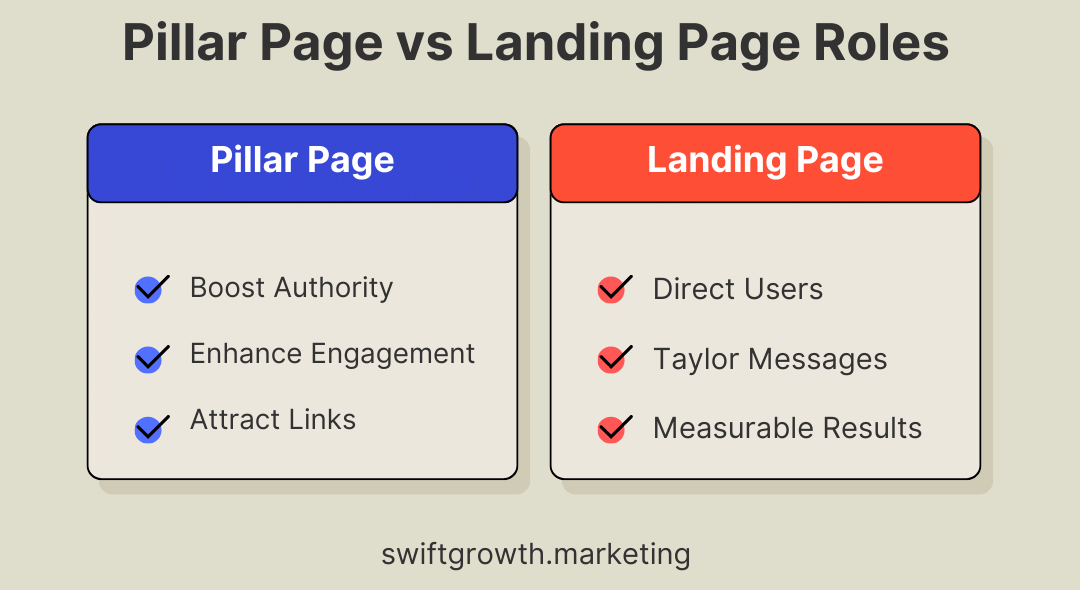
Dive into the heart of digital marketing’s toolkit where two power players, pillar and landing pages, take center stage. These aren’t just buzzwords but the cornerstones of successful online strategies. But how do they differ, and more crucially, how can you harness their distinct powers to revolutionize your digital footprint? This guide uncovers the unique roles of pillar and landing pages, providing insights to transform your approach to content and conversions.
In this comprehensive guide, we’ll decode the roles of pillar and landing pages in successful digital marketing. Whether you’re a seasoned marketer or new to the digital realm, understanding these components can transform how you approach content and conversion strategy.

What is a Pillar Page?
A pillar page acts as a comprehensive resource on a specific topic. Imagine it as the cornerstone of your content strategy, around which all related topic clusters revolve. A pillar page broadly covers all subject aspects while linking to more detailed, focused blog posts or pages.
Key Attributes of an Effective Pillar Page
These pages aren’t just content repositories but are masterfully crafted to serve as comprehensive guides on broad topics. Here, we’ll explore the key features that make pillar pages indispensable to your digital strategy.
- Broad Coverage: Unlike a typical blog post that dives deep into one aspect, a pillar page provides a wide overview of a topic, offering gateways (through links) to more detailed content.
- SEO Powerhouse: By consolidating a range of content under one broad topic, pillar pages become a magnet for search engines, often resulting in higher rankings.
- User-Centric Design: Pillar pages enhance user experience, providing a one-stop resource for readers to find comprehensive information on a topic.
The impact of pillar pages extends beyond their features. They play a pivotal role in shaping how visitors interact with your website and how search engines evaluate your content’s relevance and authority. Now, let’s delve into the integral role of pillar pages in SEO and content marketing.
The Role of Pillar Pages in SEO and Content Marketing
Pillar pages do more than just exist as part of your website – they actively enhance its SEO structure and content marketing efficacy. By understanding their role, you can leverage these pages to attract traffic and establish your site as a trusted authority in your field.
- Boosting Site Authority: Pillar pages can establish your site as an authority in your niche by offering valuable, in-depth information on key topics.
- Enhancing User Engagement: They improve the navigability of your website, keeping users engaged and reducing bounce rates.
- Link Building and Internal Linking Strategy: Pillar pages serve as a hub for internal linking, strengthening your site’s SEO structure and potentially attracting external links due to their comprehensive nature.
Effectively utilizing pillar pages in your SEO and content marketing strategies can significantly improve site performance and user engagement. By focusing on these roles, your pillar pages can become powerful tools in driving traffic and enhancing the overall authority of your website.
What is a Landing Page?
A landing page is a targeted, purpose-driven web page to achieve a specific marketing goal. These pages are the endpoint of various marketing channels where visitors land after clicking on an ad, email link, or similar. Unlike general web pages, each landing page element is fine-tuned to encourage a specific action, be it a purchase, sign-up, or download.
Key Attributes of an Effective Landing Page
Landing pages are not just about capturing leads; they’re about converting visitors into customers through a focused and persuasive approach. Let’s look at the essential attributes that make landing pages effective tools in any marketer’s toolkit.
- Clear and Compelling Headline: Grabs attention and clearly defines the offer.
- Engaging Subheadings and Copy: Provides detail and persuades the visitor to take action.
- High-Quality Visuals: Enhances engagement and complements the offer.
- Strong Call-to-Action (CTA): Clearly directs visitors towards the desired action.
- Optimized Form Fields: Gather essential information without overwhelming the visitor.
- Social Proof and Testimonials: Build credibility and trust with potential customers.
The true strength of a landing page lies in its ability to focus the visitor’s entire experience on achieving a single objective. By harnessing these key attributes effectively, a landing page becomes more than just a part of your website; it becomes a strategic asset, driving conversions and enhancing your marketing campaign’s effectiveness.
The Role of Landing Pages in Conversion and Marketing
The effectiveness of landing pages extends beyond their structural elements. They are critical in guiding visitors through the marketing funnel to conversion, acting as the linchpin in many digital marketing strategies.
- Directing Focused User Action: Landing pages guide the visitor towards a single, focused goal, increasing the likelihood of conversion.
- Tailored Messaging for Specific Audiences: They allow marketers to create messages tailored to specific audience segments.
- Measurable Results for Targeted Campaigns: With clear goals, landing pages provide valuable data on the effectiveness of marketing efforts.
Landing pages are the precision tools for conversion. When used strategically, they streamline the user’s journey to conversion and provide invaluable insights for optimizing your marketing strategies. By focusing on their distinct roles, landing pages can significantly elevate your campaign’s impact, turning prospects into valuable conversions.
Comparing Pillar Pages and Landing Pages
While pillar and landing pages are integral to a robust digital marketing strategy, they serve distinctly different purposes. Understanding these differences is crucial for marketers to leverage each page type effectively for maximum impact. Let’s dissect these differences to appreciate how each contributes to a comprehensive digital marketing strategy.
Key Differences Between Pillar Pages and Landing Pages
- Purpose and Goals: Pillar pages are designed to inform and educate, serving as a comprehensive resource on a broad topic, while landing pages are focused on conversion, encouraging a specific action from the visitor.
- Content and Structure: Pillar pages cover a wide array of information, linking out to more detailed content, whereas landing pages are streamlined and focused, with every element aiming towards the call-to-action.
- SEO vs. Conversion Optimization: Pillar pages are crafted to boost SEO through comprehensive coverage and internal linking, whereas landing pages are optimized for high conversion rates through persuasive and targeted content.
- User Journey and Engagement: Visitors engage with pillar pages to explore and learn about a topic, making them ideal for top-of-the-funnel content. On the other hand, landing pages are typically encountered at the bottom of the funnel, where the goal is to convert interest into action.
Harnessing Their Unique Strengths in Your Strategy
Understanding these differences allows marketers to craft a harmonious strategy that employs both pillar and landing pages. Pillar pages can attract and educate potential customers, building brand authority and trust. In contrast, landing pages can capitalize on this foundation, converting informed visitors into leads or customers.
By integrating both types of pages into your digital marketing plan, you can create a seamless user experience that educates, engages, and converts. This synergy enhances your online presence and drives tangible results in your marketing campaigns.
Integrating Pillar Pages and Landing Pages into a Cohesive Strategy
To maximize the effectiveness of your digital marketing efforts, it’s crucial to understand how pillar pages and landing pages can complement each other within a cohesive strategy. While they serve different functions, their roles are interconnected, guiding users through the buyer’s journey from awareness to conversion.
Strategically Aligning Pillar and Landing Pages
- Using Pillar Pages for Education and Awareness: Start employing pillar pages to educate your audience about broader topics. This approach helps build brand authority and nurture potential customers in their journey’s early stages.
- Directing Visitors to Targeted Landing Pages: Once the audience is engaged and informed, strategically guide them to specific landing pages. These pages can offer more focused content, products, or services related to the topic of the pillar page.
- Creating a Seamless Transition: Ensure a natural and seamless flow from the comprehensive content of pillar pages to the focused calls-to-action on landing pages. This transition is key to moving potential customers further down the funnel.
Leveraging Their Combined Strengths
By integrating pillar pages and landing pages, you create a powerful synergy. Pillar pages cast a wide net, attracting and informing users, while landing pages hone in on conversion. This tandem approach enhances user experience and strengthens your overall digital marketing strategy.
- Boosting Overall SEO: Pillar pages improve your site’s SEO, which drives more traffic to your landing pages.
- Enhanced User Engagement: A well-informed user from a pillar page is more likely to engage with a landing page, increasing the chances of conversion.
- Data-Driven Insights: Use data from both page types to gain insights into user behavior, preferences, and pain points, allowing for refined marketing strategies.
Conclusion: A Synchronized Approach for Maximum Impact
The integration of pillar pages and landing pages represents a strategic approach to content marketing and conversion optimization. By understanding and leveraging the strengths of both, you can create a more dynamic, effective, and user-centric digital marketing strategy. This synchronized approach not only drives traffic but also fosters engagement and conversions, ultimately contributing to the success of your online presence.
Are you ready to transform your digital presence with a strategic blend of pillar and landing pages? At Swift Growth Marketing, we specialize in crafting tailored content strategies that resonate with your audience and drive results. Don’t miss the opportunity to enhance your online visibility, engage your audience more effectively, and convert leads into loyal customers. Contact us today to discover how our expertise can elevate your digital marketing to new heights. Let’s create a dynamic, impactful online journey together!

